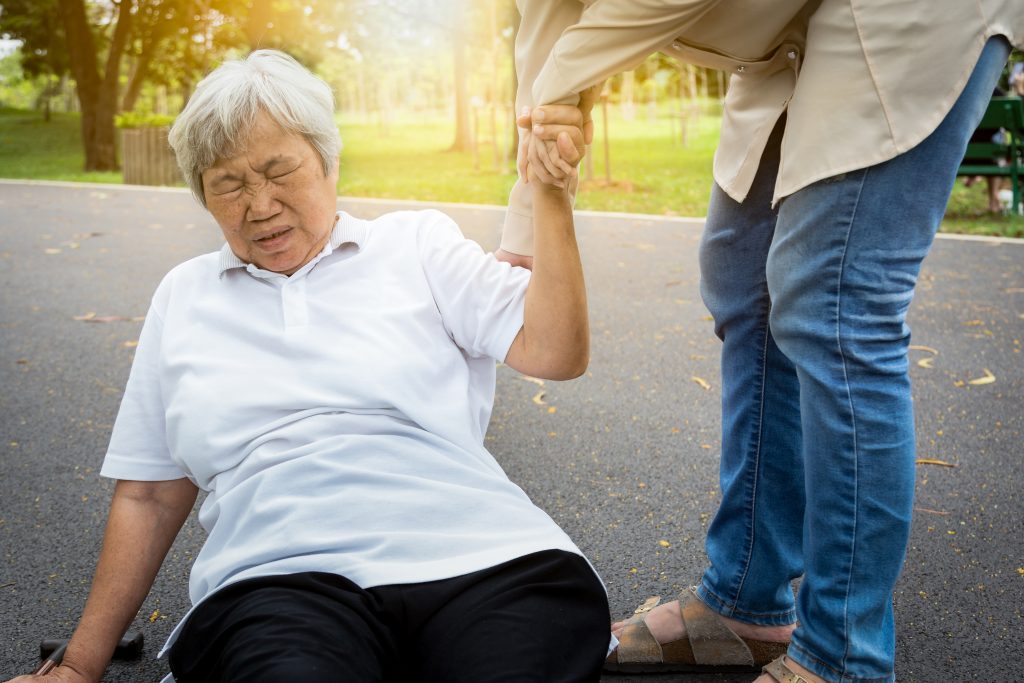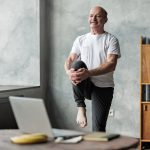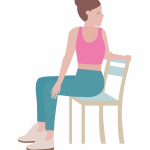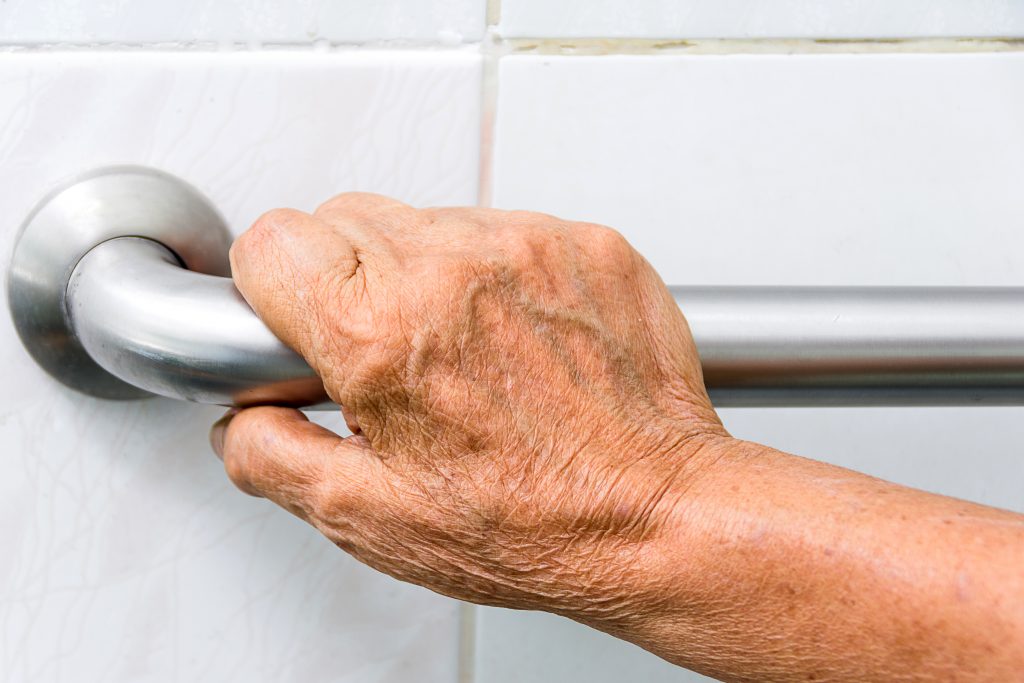June 3, 2021
Preventing Serious Falls In Older Adults
Adults aged 65 years and older are often at higher risk for falling and injuries from falls due to factors such as vision problems and the use of medications that affect balance. Falls cause disability, hospitalization, and even death. Though falls tend to be more common among older adults, you can avoid them as long as you know common causes of falls and ways to prevent them.
Dr. John P. Hood, a family medicine physician with Healthcare Associates of Texas in Arlington says, “Every year nearly 1/3 of accidental falls occur in those 60 years or older with 10% resulting in serious injury.”
Here’s how to prevent falls in the elderly and steps you should take in the event you experience a fall.
Risk Factors and Causes Of Falls In The Elderly
Falls among older adults are often caused by a combination of risk factors. The Centers for Disease Control and Prevention reports that an older adult’s risk of falling doubles after they experience the first fall.
Risk factors for falling include:
- Vitamin D deficiency
- Weakness in the lower body
- Low physical activity level

- Slowed reflexes
- Use of medications and over-the-counter medicines that affect balance and vision
- Alcohol use
- Vision impairment
- Poorly fitting shoes
- Foot pain/ ankle disorder
- Chronic diseases
- Surgical procedures
- Environmental hazards, such as a cluttered home
Dr. Hood adds that “age, muscle weakness, gait or balance problems, poor vision, postural hypotension, chronic conditions, poor stair design, lack of bathroom bars, dim lighting, slipperiness, and obstacles are all also common risk factors for falls.”
Can Medication Affect Balance?
Certain medications can affect balance and coordination and subsequently increase the risk of falls in older adults. Some medications may also cause dizziness, drowsiness, and vision impairment to increase the risk of falling.
Medications that are known to affect balance include:
- Antidepressants including selective serotonin reuptake inhibitors (SSRIs) and serotonin-norepinephrine reuptake inhibitors (SNRIs)
- Benzodiazepines such as diazepam and alprazolam
- Antihistamines
- Alpha-blockers
- Angiotensin-converting-enzyme (ACE) inhibitors
- Angiotensin-receptor blockers (ARBs)
- Beta-blockers
- Anticholinergic / antispasmodic drugs for stomach cramps
- Diabetes drugs such as insulin and glyburide
- Opioids such as oxycodone and hydrocodone
- Nonsteroidal anti-inflammatory drugs (NSAIDs)
- Sedatives and hypnotics such as zolpidem and butabarbital
- Digoxin
- Diuretics and water pills
When starting a new medication, read the package insert and talk to your doctor to learn more about all potential risks and side effects, including the risk of falling. If possible, try to limit the number of medications you use that contribute to falling or ask your doctor about other treatments that pose a lower risk. If taking one or more of the above medications is unavoidable for your condition, be extra cautious when moving around and doing activities that could potentially lead to a fall.
Which Medical Conditions Can Affect Balance?
Certain diseases and medical conditions can also affect balance to increase the risk of falls. Impaired vision and other eye conditions such as glaucoma and cataracts can cause problems with depth perception and make it difficult to detect the location of stairs and thresholds. Diabetes, due to nerve damage in the feet can make it difficult to walk which can affect balance.
Other medical conditions that can affect balance include:
- Calluses, hammertoes, bunions, and other foot conditions can cause difficult
- Neurological conditions including multiple sclerosis, stroke, and Parkinson’s disease. Hood adds, “Parkinson’s interacts with nerves that controls our body when moving and can make easy movement difficult.”
- Low blood pressure (hypotension), which can lead to dizziness or fainting when standing up
- Dr. Hood explains that vertigo is, “a sensation that the environment around you is moving and/or spinning.”
- Vestibular neuritis, an inflammatory disorder that affects nerves in the ear responsible for balance can cause difficulty walking
- Migraines, which can cause dizziness/ visual disturbances
- Dehydration, which can lead to hypotension and temporary loss of consciousness
How Older Adults Can Increase Bone Strength
Osteoporosis is a common risk factor for injuries and fractures that can occur when falling. Osteoporosis tends to be more common among older adults whose bones have become weak and brittle due to reduced hormone levels, low calcium and vitamin D intake, and low physical activity levels.
Older adults who take steps to increase bone strength can reduce their risk for both falls and osteoporosis. These steps include:
- Exercising on most days of the week. Hood says older patients should try “strength training and weight bearing exercises.”
- Consuming the recommended amount of calcium and vitamin D. Hood recommends, “people aged 50-70 should take 1,200mg per day of calcium and 600IU per day of vitamin D. While people 70 and up should have 1,200mg per day of calcium and 800IU per day of vitamin D.”
- Taking medications that slow bone loss.
Exercises That Help With Balance
Most types of exercise can help with balance, though muscle-strengthening exercises are usually the most effective for fall prevention and improving balance. Older adults should also focus on balance exercises to prevent falls.
Try these exercises that may help with balance:
 Stand touching the back of a chair, a wall, or a counter. Lift one knee to practice standing on one leg at a time for one full minute. Gradually increase the time you spend standing on each leg. Also, try balancing with your eyes closed or without touching anything for support.
Stand touching the back of a chair, a wall, or a counter. Lift one knee to practice standing on one leg at a time for one full minute. Gradually increase the time you spend standing on each leg. Also, try balancing with your eyes closed or without touching anything for support.
 Stand and hold the back of a chair or countertop. Stand on your toes and count to 10. Then, slowly rock back to balance on your heels and count to 10.
Stand and hold the back of a chair or countertop. Stand on your toes and count to 10. Then, slowly rock back to balance on your heels and count to 10.
 Stand up and hold the back of a chair or countertop with both hands. Move your hips to make a big circle to the right without moving your feet or shoulders, then repeat this same movement to the left. Repeat this exercise five times.
Stand up and hold the back of a chair or countertop with both hands. Move your hips to make a big circle to the right without moving your feet or shoulders, then repeat this same movement to the left. Repeat this exercise five times.
Yoga and Tai Chi are other types of exercises that can help improve muscle strength and balance. Ask your doctor or local gym about yoga and Tai Chi classes available for adults in your age group.
Preventing Falls At Home
Changes to your indoor living environment can make your home significantly safer and reduce the risk of falls. Without the necessary precautions, falls can lead to serious injuries including broken bones, hip fractures, and head injuries.
Here are elderly fall prevention tips for the home:
- Remove all clutter from rooms, including from the floor.
- Wear shoes or socks with rubber or non-skid soles.
- Place bright lights, lamps, and nightlights in all rooms of the house.

- Make sure all rugs and carpets are tacked to the floor.
- Install grab bars in your shower, bathtub, and next to the toilet.
- Place non-slip bath mats inside and outside of the shower.
- Make sure railings next to stairs are sturdy.
- Avoid placing electrical and phone cords across walkways.
- Use sturdy ladders and step-stools with rubber grips or ask someone else in your household to reach high objects.
Dr. Hood emphasizes to, “avoid dimly lit rooms and slippery areas. Any slippery area, especially in the bathroom, should have a grab bar to prevent a serious fall.”
What To Do After Experiencing a Fall
Keep your phone nearby or in your pocket at all times if you meet any risk factors for falling. If you have fallen in your home and there is no caregiver or relative available to help, remain calm, take a few deep breaths, and examine yourself for injuries. If you are hurt or injured, call your caregiver or emergency medical services to receive further assistance.
If you do not feel hurt or injured, slowly roll onto your side until you can safely get onto your hands and knees. Crawl over to a nearby piece of sturdy furniture if possible, get into a kneeling position, and use the furniture to prop yourself up and stand.
Contact your doctor after you’ve had a fall so you can talk about potential causes and begin or change treatment.
“Your doctor will be able to examine you, review your risk factors, and discuss safe proofing your home. Your doctor can also review your medications to determine if those contributed to the fall,” Dr. Hood explains.
If you are using one or more medications that may have contributed to your fall, your doctor may prescribe a different medication with a lower risk.
How Your Doctor Can Help
First, your doctor may ask you a series of questions to determine why you may have fallen, such as medications, possible clutter, slippery surfaces or symptoms of medical conditions common in fall patients. Your doctor may test for or rule out conditions that could have made you feel weak or dizzy, such as dehydration, pneumonia, and a mini-stroke.
Other tests your doctor may perform include:
- Blood tests that check sodium levels, electrolytes, and kidney function
- Blood pressure check
- Blood sugar testing
- Pulse check
- Vitamin D check
- Balance/gait assessment
- Mobility test
- Reflex test
- Heart evaluation
- Neurological evaluation
- Vision test
- Bone density test
- Brain imaging
- Memory test
Your doctor may also perform a fall risk assessment to determine whether you have a low, moderate, or high risk of falling. During this assessment, your doctor may time your walking pace and check your strength and balance. After reviewing your results, your doctor may work with you to develop an exercise and nutrition plan, and suggest changes you can make to your living environment to reduce the risk of falling.
Healthcare Associates of Texas is home to a large team of board-certified doctors and medical professionals who can help you prevent falls and treat medical conditions contributing to falls. To make an appointment, request an appointment on our website.
Follow us on social media! Facebook, Instagram, Twitter, YouTube.
DISCLAIMER
The information featured in this site is general in nature. The site provides health information designed to complement your personal health management. It does not provide medical advice or health services and is not meant to replace professional advice or imply coverage of specific clinical services or products. The inclusion of links to other web sites does not imply any endorsement of the material on such websites.
